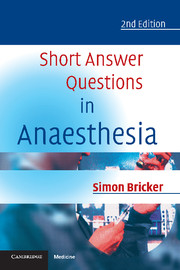Book contents
- Frontmatter
- Contents
- Preface
- Preface to the 1st edition
- Abbreviations
- 1 Advice on answering short answer questions
- 2 General Anaesthesia
- 3 Anaesthesia and Medical Disease
- 4 Medicine and Intensive Care
- 5 Obstetric Anaesthesia and Analgesia
- 6 Paediatric Anaesthesia
- 7 Neuroanaesthesia
- 8 Acute and Chronic Pain
- 9 Trauma and Emergency Anaesthesia
- 10 Anatomy, Applied Anatomy and Regional Anaesthesia
- 11 Pharmacology and Applied Pharmacology
- 12 Clinical Measurement and Equipment
- 13 Cardiac and Thoracic Anaesthesia
- Index
9 - Trauma and Emergency Anaesthesia
Published online by Cambridge University Press: 05 February 2014
- Frontmatter
- Contents
- Preface
- Preface to the 1st edition
- Abbreviations
- 1 Advice on answering short answer questions
- 2 General Anaesthesia
- 3 Anaesthesia and Medical Disease
- 4 Medicine and Intensive Care
- 5 Obstetric Anaesthesia and Analgesia
- 6 Paediatric Anaesthesia
- 7 Neuroanaesthesia
- 8 Acute and Chronic Pain
- 9 Trauma and Emergency Anaesthesia
- 10 Anatomy, Applied Anatomy and Regional Anaesthesia
- 11 Pharmacology and Applied Pharmacology
- 12 Clinical Measurement and Equipment
- 13 Cardiac and Thoracic Anaesthesia
- Index
Summary
What fluids are available for the restoration of circulating volume in a patient suffering from acute blood loss? Discuss the advantages and disadvantages of each.
Arguments about optimal resuscitation of the intravascular compartment continue, the role of albumin remains controversial, and there are persistent concerns about the safety of homologous blood transfusion. This question examines your knowledge of these areas while also testing one of your emergency skills.
Introduction
There are three main groups of fluids which are used to resuscitate the intravascular compartment folllowing acute blood loss: crystalloid solutions, colloids and blood. Solutions such as perfluorocarbons and stroma free haemoglobin may offer some future promise in terms of oxygen carriage but are not available and will not be discussed. There is no consensus about the optimum regimen but the main arguments for and against each can be summarised as follows.
Crystalloid solutions
Crystalloid. Acrystalloid solution is defined chemically as one which contains a water soluble crystalline substance capable of diffusion through a semipermeable membrane.
Examples. Include Hartmann's solution (Compound Sodium Lactate Intravenous Infusion or Ringer-Lactate Solution for Injection), Ringer's Solution for Injection (NaCl 0.9%), Hypertonic Saline (NaCl 3.0%), Dextrose (4%)/Saline (0.18%) and Glucose (5%).
Crystalloid advantages
— Readily available and cheap.
— Balanced salt solutions approximate ECF composition.
— Simple to infuse large volumes.
Crystalloid disadvantages
— Duration in circulation is very short: 50% in ECF/ICW after 20 minutes.
— Hartmann's is contraindicated in diabetes (lactate is gluconeogenic).
— Large sodium and water load.
— Potential for overinfusion, pulmonary oedema, subsequent ARDS.
— Glucose distributes throughout body water: minimal effect on intravascular volume.
— No oxygen carrying capacity.
- Type
- Chapter
- Information
- Short Answer Questions in Anaesthesia , pp. 231 - 246Publisher: Cambridge University PressPrint publication year: 2002



